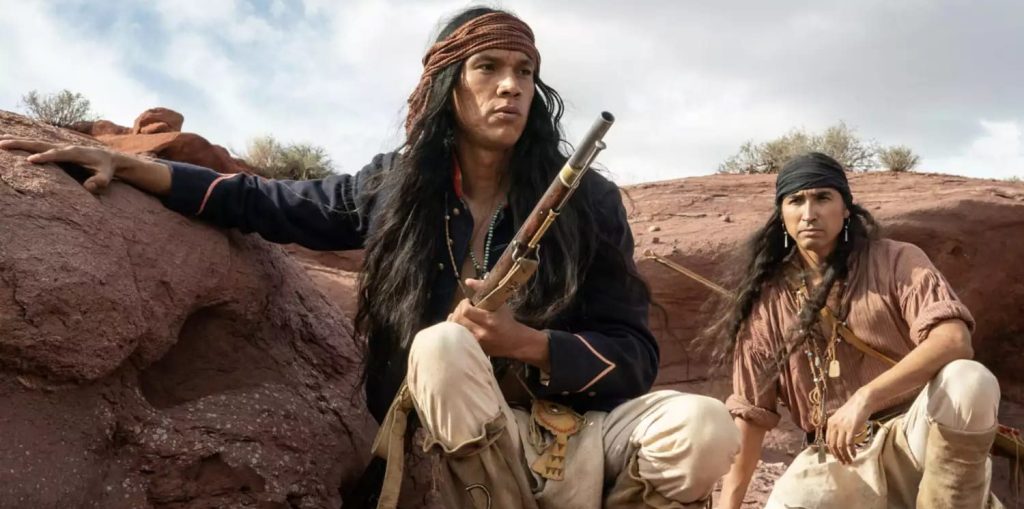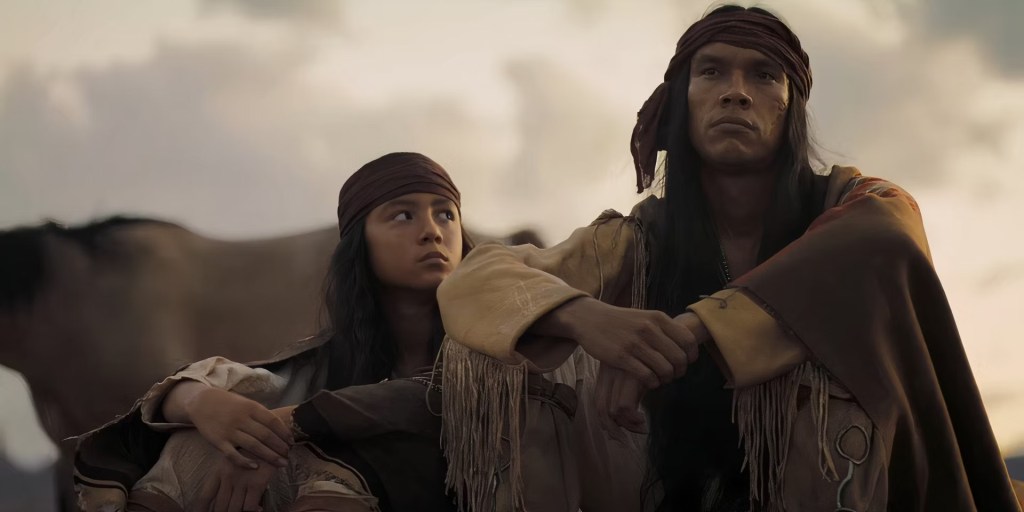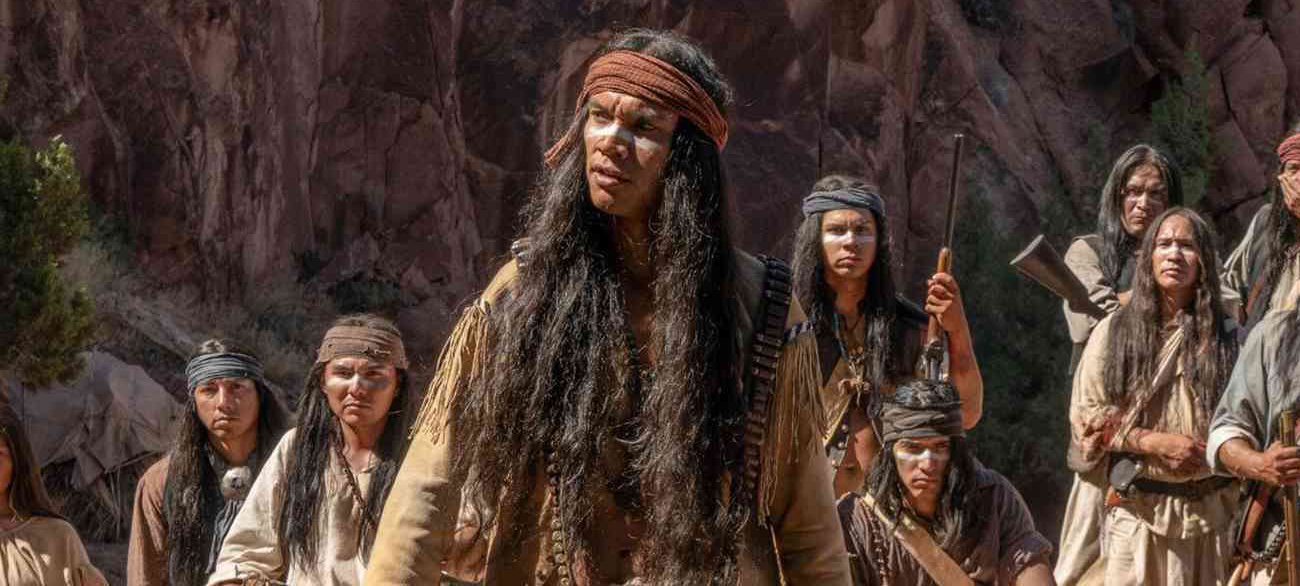Kevin Costner’s ‘Horizon: An American Saga – Chapter 1‘ revolves around the interconnected lives and conflicts of several people and groups in the American frontier against the backdrop of the impending Civil War and tensions between Native American tribes and white settlers. As hostilities grow between the two factions, a member of the White Mountain Apache tribe, Pionsenay, makes his opinion known as he rallies his people to get rid of those who have trespassed into Indigenous lands without hesitation. Owing to his youth and fiery passion, Pionsenay, like many real Native American leaders, takes matters into his own hands after witnessing Tuayeseh, the tribe elder, preach the path of non-violence, which he is tired of adhering to like most of his clanmates!
Pionsenay is a Fictional Native American Leader
Pionsenay is a fictional character in ‘Horizon: An American Saga – Chapter 1.’ He was conceived by Kevin Costner and his co-writer Jon Baird for the film. As a warrior who holds strong influence within the Apaches, Pionsenay becomes a new rallying force with a view that the white settlers who are inching into their land and taking up vital hunting space must be fought with the brutality of war. In doing so, Pionsenay goes against his tribe elder Tuayeseh and his vehement belief that they must steer clear of the frontier folk and try to get along with them through peaceful negotiations.

In an interview with EW, Owen Crow Shoe, who plays Pionsenay, elaborated on the essence of the character and what drives him, stating, “Originally, he’s a peaceful warrior, and he doesn’t take too well to violence. He wants to keep the violence away as much as he can, and he doesn’t want to fight if he doesn’t have to. But his perspective starts to change as the settlers start making their way over, and he is starting to notice that the world around him is changing. He believes that they can’t just sit idly by while the settlers are making their way West.” Consequently, Pionsenay decides to break away from Tuayeseh’s tribe and continue his crusade of war against the settlers.
Much of Pionsenay’s discontent stems from his belief that Tuayeseh has grown soft and blind in the mountains and does not realize the threat the settlers pose. Having lived through several years of turmoil himself, Tuayeseh is guided by his wisdom and his dreams, certain that the cycle of violence will continue to escalate if Pionsenay stays on his course of aggression. However, the young Apache warrior is frustrated by the lack of action taken by the tribe elder, fearing worse things may happen if no one does anything. As a result, he picks up the reins and leads an army to hunt down the settlers.
The Protection of the Apache’s Future Guides Pionsenay’s Battle
Although Pionsenay is fictional, his reasons for fighting the settlers can be traced back to the history of Native American tribes who lived in the frontiers long before a variety of groups moved into Indigenous lands and took over their resources. “We were there for thousands of years, and we knew the land like the back of our hands — where the resources were, when the herd of deer or whatever animal we’re hunting would be, [and] when it would be where. Everything was so connected back then,” Owen Crow Shoe, who is a Native American, added. This concern becomes the driving force of Pionsenay, as he believes that these natural flora and fauna will be taken away from his people if no one stands against the settlers and fights them back.

Pionsenay’s raids can be paralleled with the historical campaign of Victorio, a warrior and chief of the central Apaches, who led an armed conflict against the U.S. and Mexican armies from 1879 to 1880. The Apache leader employed guerrilla warfare tactics with less than 200 men against both the army and civilian populations, incurring several losses against his opposition. His skirmishes and battles came to an end in October 1880 at the Battle of Tres Castillos, where he was killed, and his followers suffered the same fate or were captured. Despite sharing several similarities with Pionsenay’s campaign against the settlers, Victorio was 55 when he began his war. His campaigns were part of the Apache Wars, which were a number of armed confrontations between the Apache tribe and the U.S. Army between 1849 and 1886.
‘Horizon: An American Saga – Chapter 1’ reflects these run-ins between the Apache and the rest of the United States population through Pionsenay’s battles. Ultimately, the young warrior’s strength lies in his conviction – misguided or not – as the fate of his people falls on his shoulders despite ignoring the warning from Tuayeseh. While Pionsenay causes several deaths to prove his point, in his perspective, these are justified considering the cruelties he has witnessed against other tribes, similar to how several Native American warriors seemingly thought about their actions. Fearing the fall of his own clan, he retaliates, hoping that it will send a message to the settlers to stop their expansion. While his motivations and actions can be linked to historical and real-life Native American sentiments and chiefs, the Apache warrior is a fictional leader who did not exist in reality.
Read More: Where Was Horizon: An American Saga Filmed?


You must be logged in to post a comment.